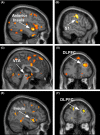The highly sensitive brain: an fMRI study of sensory processing sensitivity and response to others' emotions
- PMID: 25161824
- PMCID: PMC4086365
- DOI: 10.1002/brb3.242
The highly sensitive brain: an fMRI study of sensory processing sensitivity and response to others' emotions
Abstract
Background: Theory and research suggest that sensory processing sensitivity (SPS), found in roughly 20% of humans and over 100 other species, is a trait associated with greater sensitivity and responsiveness to the environment and to social stimuli. Self-report studies have shown that high-SPS individuals are strongly affected by others' moods, but no previous study has examined neural systems engaged in response to others' emotions.
Methods: This study examined the neural correlates of SPS (measured by the standard short-form Highly Sensitive Person [HSP] scale) among 18 participants (10 females) while viewing photos of their romantic partners and of strangers displaying positive, negative, or neutral facial expressions. One year apart, 13 of the 18 participants were scanned twice.
Results: Across all conditions, HSP scores were associated with increased brain activation of regions involved in attention and action planning (in the cingulate and premotor area [PMA]). For happy and sad photo conditions, SPS was associated with activation of brain regions involved in awareness, integration of sensory information, empathy, and action planning (e.g., cingulate, insula, inferior frontal gyrus [IFG], middle temporal gyrus [MTG], and PMA).
Conclusions: As predicted, for partner images and for happy facial photos, HSP scores were associated with stronger activation of brain regions involved in awareness, empathy, and self-other processing. These results provide evidence that awareness and responsiveness are fundamental features of SPS, and show how the brain may mediate these traits.
Keywords: Emotion; empathy; highly sensitive person; magnetic resonance imaging; mirror neurons; sensory processing sensitivity.
Figures



References
-
- Acevedo B. Neural correlates of human attachment: evidence from fMRI studies of adult pair-bonding. In: Zayas V, Hazan C, editors. Bases of adult attachment: from brain to mind to behavior. New York, NY: Springer; 2014.
-
- Aharon I, Etcoff N, Ariely D, Chabris CF, O'Connor E, Breiter HC. Beautiful faces have variable reward value: fMRI and behavioral evidence. Neuron. 2001;32:537–551. - PubMed
-
- Aron EN, Aron A. Sensory-processing sensitivity and its relation to introversion and emotionality. J. Pers. Soc. Psychol. 1997;73:345–368. - PubMed
-
- Aron E, Aron A, Davies KM. Adult shyness: the interaction of temperamental sensitivity and an adverse childhood environment. Pers. Soc. Psychol. Bull. 2005a;31:181–197. - PubMed
Publication types
MeSH terms
LinkOut - more resources
Full Text Sources
Other Literature Sources
Medical
Research Materials

